A while ago, I posted some data showing an increase in odd-order harmonic distortion caused by reticulated foam in the throat of a compression driver. Later, I discovered that this is a well-known effect of porous absorbers at high SPL.
Today, I decided to see if I could measure any nonlinearity caused by relatively thin polyester grille cloth in front of a woofer. I used a cardioid dynamic mic (it has lower distortion than my measurement mic at high SPL), so the frequency response is not terribly accurate and the overall SPL is incorrect (not a problem in this case). The woofer is an Eminence Deltalite II 2512 driven at approx. 6.3V RMS (~5W@8ohm; around 105dB mid band at 1 meter in half space). The mic was placed about 20° off axis and ~7.5cm (3") from the grille.
Here's the distortion with no grille cloth:
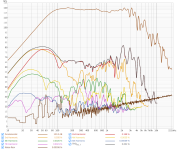
And with the grille cloth:
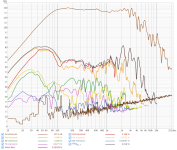
As with the foam, the repeatability of the measurements is good. I also measured a second woofer (same model) and got similar results. I doubt the effect shown is audible, but I was surprised by how significant it seems to be.
Today, I decided to see if I could measure any nonlinearity caused by relatively thin polyester grille cloth in front of a woofer. I used a cardioid dynamic mic (it has lower distortion than my measurement mic at high SPL), so the frequency response is not terribly accurate and the overall SPL is incorrect (not a problem in this case). The woofer is an Eminence Deltalite II 2512 driven at approx. 6.3V RMS (~5W@8ohm; around 105dB mid band at 1 meter in half space). The mic was placed about 20° off axis and ~7.5cm (3") from the grille.
Here's the distortion with no grille cloth:

And with the grille cloth:

As with the foam, the repeatability of the measurements is good. I also measured a second woofer (same model) and got similar results. I doubt the effect shown is audible, but I was surprised by how significant it seems to be.
Last edited:
Perhaps proximity to the surround causes amplification of the surround's nonlinearity? Or just the nonlinearity of the grill as it moves in and out with the speaker?
I wonder how it is affected by the tension of the fabric?
I wonder how it is affected by the tension of the fabric?
Can you do an FFT? Maybe the grille has a resonance.
In single frequency tests I can supposedly hear half a permille distortion, so 60 dB down would be audible. I doubt I could hear it in music though.
In single frequency tests I can supposedly hear half a permille distortion, so 60 dB down would be audible. I doubt I could hear it in music though.
The dominant factor is nonlinear resistance to flow, as far as I am aware, which is an inherent property of any porous material. See this paper for more info: D. A. Nelson, "Interaction of finite-amplitude sound with air-filled porous materials" (1985).Perhaps proximity to the surround causes amplification of the surround's nonlinearity?
Increased tension should decrease the resistance, which should decrease the nonlinear contribution somewhat.
The magnitude of the fundamental is shown in the plots I posted. The difference between the two is within ±0.5dB up to 4kHz.Can you do an FFT? Maybe the grille has a resonance.
Not a whole lot to be seen in the burst decay. No grille, 1/3 octave:
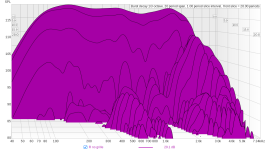
With grille, 1/3 octave:
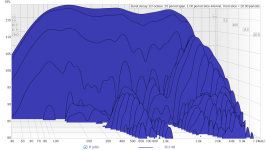
No grille, 1/6 octave:
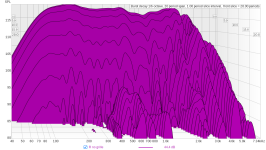
With grille, 1/6 octave:
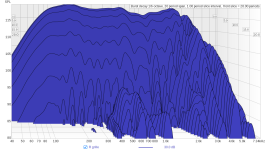
I think a mechanical resonance/buzz would generally tend to produce both even- and odd-order harmonics, but the measurements show very little difference in the even-order harmonics. Especially above 100Hz or so, only the odd orders are significantly affected.

With grille, 1/3 octave:

No grille, 1/6 octave:

With grille, 1/6 octave:

I think a mechanical resonance/buzz would generally tend to produce both even- and odd-order harmonics, but the measurements show very little difference in the even-order harmonics. Especially above 100Hz or so, only the odd orders are significantly affected.
I know the effect shown would never have been audible to me even when my hearing was good.I doubt the effect shown is audible, but I was surprised by how significant it seems to be.
The difference in frequency response between your two Deltalite II 2512 drivers is probably several dB more than the difference between the ±0.5dB with and without grille cloth, if your Eminence drivers are similar to the dozens I've owned.
I'm surprised a 0.017 difference in loudspeaker THD would seem significant to anyone, but your test is good proof that decent grille cloth is not an audible problem 🙂
That said, grille frames can cause audible problems.
Art
Before I did the measurements, I was thinking that the grille cloth nonlinearity would probably be swamped by that of the driver so I was surprised to see a ~10dB increase in the 3rd harmonic over more than an octave. At the cursor location (165Hz), the 5th harmonic jumps a full 20dB.I'm surprised a 0.017 difference in loudspeaker THD would seem significant to anyone
My particular drivers differ by less than 0.5dB up to almost 2kHz. Perhaps I got lucky.The difference in frequency response between your two Deltalite II 2512 drivers is probably several dB more than the difference between the ±0.5dB with and without grille cloth, if your Eminence drivers are similar to the dozens I've owned.
Given that we’re looking at results involving measurements 60-90+ db less than the fundamental, how much of that change can be attributed to a change in noise floor?
It's well above the noise floor in this case. Noise wouldn't produce a smooth line, and it's extremely unlikely that a swept tone would appear at exactly the right time and pace. Even if it did, there would be numerous reflections.
If you lower the Fs of the cloth by hanging it, it may be more likely to move with the woofer, but it is still much denser than air so I think the air would be forced through anyway. That's just my theory though.
What if you turn the grill around so the fabric is closer to the woofer? Does bringing it closer increase or decrease the distortion?
What if you turn the grill around so the fabric is closer to the woofer? Does bringing it closer increase or decrease the distortion?
All harmonics shown are above the noise floor in the range of interest.how much of that change can be attributed to a change in noise floor?
I may try to test that at some point. My guess is that the distortion would increase slightly except perhaps at very low frequencies.What if you hang the cloth only from above without any tension?
It can't really get much closer in this case. The cloth is stretched over a thin hoop made of white oak (steam bent) which fits snugly over the driver's front gasket.What if you turn the grill around so the fabric is closer to the woofer? Does bringing it closer increase or decrease the distortion?
Increasing or decreasing the sound pressure at the surface of the cloth will increase or decrease the distortion, respectively.
Harmonics are going to be generated whenever sound changes from one medium to another. However, the amplitude is going to be a deciding factor when it comes to the severity of the distortion.
https://en.wikipedia.org/wiki/Nonlinear_acoustics
Now unfortunately, loud sounds also seem to distort when the medium doesn't change.
https://www.researchgate.net/public...distortion_in_sound_systems_-_Can_we_avoid_it
https://en.wikipedia.org/wiki/Nonlinear_acoustics
Now unfortunately, loud sounds also seem to distort when the medium doesn't change.
https://www.researchgate.net/public...distortion_in_sound_systems_-_Can_we_avoid_it
Yes, air nonlinearities can be very significant if SPL is sufficiently high. A compression driver and horn is a good example. The throat diameter at the phase plug exit in a typical 1 inch compression driver is around 18mm. Assuming 25% efficiency, the sound pressure at this point with only 100mW input is approx. sqrt(0.1W × 25% × 415Ns/m³ / 0.000254m²) → 202Pa → 140.1dB SPL.Now unfortunately, loud sounds also seem to distort when the medium doesn't change.
Sound speed is higher for the compression phase and lower for the rarefaction phase, so the waveform distorts toward a sawtooth shape as the wave propagates because the high pressure regions "pile up" against the low pressure regions. This is why long, slow-expansion horns have higher distortion than short horns at high frequencies: the sound pressure is high for a longer distance in the slow-expansion horn.
How do we know “it’s well above” the noise floor if we were not there? Perhaps you were there, I don’t know. If you were, you’d have insight into my concern explained below.It's well above the noise floor in this case. Noise wouldn't produce a smooth line, and it's extremely unlikely that a swept tone would appear at exactly the right time and pace. Even if it did, there would be numerous reflections.
Kids playing, a car driving by, sudden wind gust, ice falling from the ice maker fridge turning on, or any other internal/external noises change the noise floor and are not swept tones. If they take place during a sweep, they could impact the results and thus why I asked my question. I was curious what measures were taken to maintain a consistent noise floor and eliminate spurious noises from impacting results.
Was this a living room in an apartment in the middle of the day with volatile background urban noise? Was it a secluded basement listening room at night with the HVAC and other equipment turned off, far from neighbors with lots of acoustic isolation resulting in consistently low background noise? Was it something in the middle of those two scenarios?
Even with a Klippel, the noise floor still impacts results and can be seen in the IMD tests at Erin’s audio corner. When looking at distortion products 90’ish db below the fundamental, a spurious noise could easily change the testing results without taking multiple tests over time and averaging the results.
3rd harmonic is most important change, and at surpisingly wide range (200-600Hz). Mechanical resonance of eg. loose wire makes H3 rise with a sharp peak.
But distortion is -50dB, hardly audible.
Can you show the fabric, how thick and how tight weave?
ps. I have seen a change in H3 when holding a finger on the frame of a poorly attached driver...
But distortion is -50dB, hardly audible.
Can you show the fabric, how thick and how tight weave?
ps. I have seen a change in H3 when holding a finger on the frame of a poorly attached driver...
Even with a Klippel, the noise floor still impacts results and can be seen in the IMD tests at Erin’s audio corner. When looking at distortion products 90’ish db below the fundamental, a spurious noise could easily change the testing results without taking multiple tests over time and averaging the results.
In this case it's only 60db. The Klippel analyzer uses different algorithms than REW and every algorithm has different suitability for different purposes. If you take Klippel as the gold standard to question everything else without understanding the underlying technologies, then this is not objectivity but a concerning lack of skepticism.
An easy way to confirm the amount of interference is to use the "harmonic frequency as reference" option and see whether the harmonics straighten out. Harmonics generated at or before the coil former all radiate through the cone's normal acoustic response so when you normalize them to the response, what you see is the smooth pattern of harmonics consistent with the underlying physics of the motor parts and suspension. Anything coming from a different direction will jump out.
This is the exact product. It's fairly sheer if backlit, but looks opaque in front of a black woofer cone. Thickness is approx. 0.55mm (0.022"). Here's a close-up photo showing the structure, backlit by my computer screen:Can you show the fabric, how thick and how tight weave?

Closer to the latter. As I said before, the results were quite repeatable across multiple measurements and with two different drivers.Was this a living room in an apartment in the middle of the day with volatile background urban noise? Was it a secluded basement listening room at night with the HVAC and other equipment turned off, far from neighbors with lots of acoustic isolation resulting in consistently low background noise?
- Home
- Loudspeakers
- Multi-Way
- Nonlinear effects of grille cloth